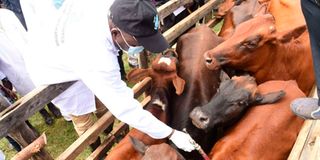Premium
Ways animals can live with pathogens, but be disease-free

A health professional vaccinates animals in Baringo in 2020 during the launch of a vaccination drive.
The case of livestock, human and wild animal diseases and their persistence tends to baffle farmers and other readers alike. I keep getting questions on why the disease-causing organisms cannot be eliminated totally so that people and their animals can live happily ever after.
My answer to this question is always simple and philosophical. First, all living things were created with a right to life and to propagate their species in perpetuity. Second, as human beings our best bet is to live and let live.
When we exterminate other species, we must also be aware that those supposedly nuisance species may actually be useful to us, our livestock and the environment from other perspectives.
For instance, we know that all animal species including human beings carry billions of micro-organisms on their skin, mucous membranes and in the gut.
In medical science, they are called the normal flora. Their presence on body surfaces helps in preventing infection on the skin, respiratory and reproductive systems and the intestines. They also help in digestion.
Antibiotics
Animals and humans get very sick if antimicrobials are over-used and they eliminate the normal flora. I recall one case of a farmer who kept giving her calves antibiotics and they would die of diarrhoea. The problem was resolved after she withdrew the medicines and allowed the animals to rebuild their normal flora.
Two weeks ago, I visited a pig farmer in Kiambu who wondered why veterinary doctors and researchers cannot come up with ways of eliminating pathogens. His piglets kept having diarrhoea. Some would die and others became weak and stunted. Eventually, they would have very low weight even at eight months of age. Pig farmers dread such piglets.
I explained to the Kiambu farmer that in medical science, we mainly devise ways of living with disease-causing organisms rather than trying to eradicate them.
The reason is that even when we talk of eradicating diseases, they will usually get eliminated in human and livestock populations that are well-managed, but still survive in the wild or the general environment.
The most common and effective ways of living with pathogens without getting infected or without getting severe disease in your animals are well-prescribed in science. The first line of defence is good hygiene. This involves cleanliness, disinfection and isolation. Isolation refers to keeping your animals well-fenced off from other animals so that you can carry out all your disease prevention and control measures without interference from other animal populations or your animals interacting with contaminated environments.
The second method is to ensure your animals are well-fed with a balanced diet. This enables the animals to develop good immunity against diseases.
Good shelter
The third method is to provide good shelter that protects the animals from harsh weather. Too much heat or too much cold stresses animals and causes diseases. The good environmental temperature range for most livestock is 10 to 30 degrees Centigrade.
Fourth, vaccination of animals is very useful in protecting livestock from getting infected or getting severe disease. Unfortunately, not all diseases have vaccines. However, most severe diseases like foot and mouth (FMD), rabies, rinderpest and anthrax have highly effective vaccines.
Vaccination does not mean that the disease-causing organisms have been eradicated. It only means that properly vaccinated animals get the disease organisms but their bodies are able to neutralise the pathogens before they can cause diseases. Vaccination has to be done repeatedly at prescribed times because over time, the level of protection in the body declines and infection can occur.
Finally, when all disease prevention measures fail, diseases are treated with the appropriate antimicrobial drugs.
Antimicrobials are drugs that kill disease-causing agents. Antibiotics, on the other hand, are drugs that kill micro-organisms but they are obtained from other micro-organisms. In most cases when people talk of antibiotics, they actually are referring to anti-microbials. Penicillin, derived from the fungus penicillium, was the first antibiotic to be discovered.
Pathogens, as we know them today fall into several categories. The most common are bacteria such as anthrax. They cause a wide range of diseases in livestock. Some bacterial diseases are prevented using vaccines but the majority are controlled through hygiene, isolation and treatment.
Farmers should always check with their animal health service providers the best methods in their area based on the types of diseases present.
Severe livestock diseases
Viruses are also very common. Majority of them cause mild or no disease in livestock. There are many vaccines for the most common and severe livestock diseases such as FMD and lumpy skin disease.
Other pathogens are protozoans which are blood parasites or they affect other tissues. Most have no vaccines and are managed through hygiene in control of the parasites like ticks and flies that transmit them to animals. There are also medications for most protozoans such as parvaquone and buparvaquone for East Coast fever.
Large parasites such as worms cause various livestock diseases and they are controlled through hygiene, isolation and treatment.
Fungi are the last class of pathogenic micro-organisms and they are controlled through hygiene and treatment. The final class of disease causing agents is prions. These are proteins that cause changes in the brain such as in mad cow disease.
There is no treatment or vaccine for this class of diseases. Prevention is done through hygiene by destroying all infected animals or those in contact with infected ones.





